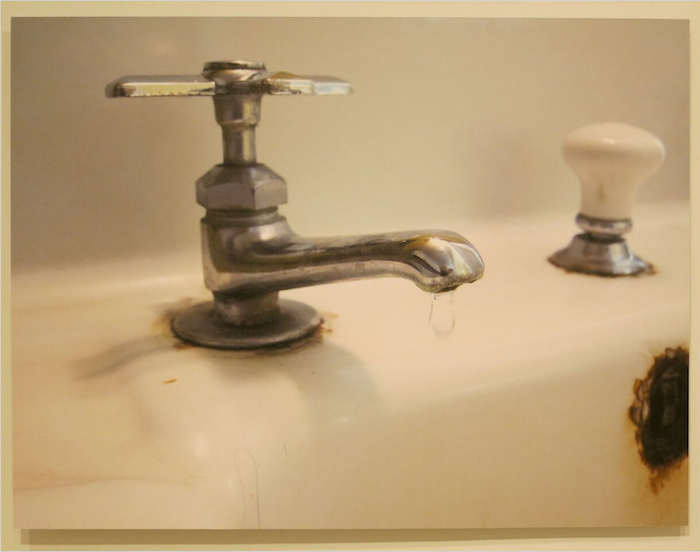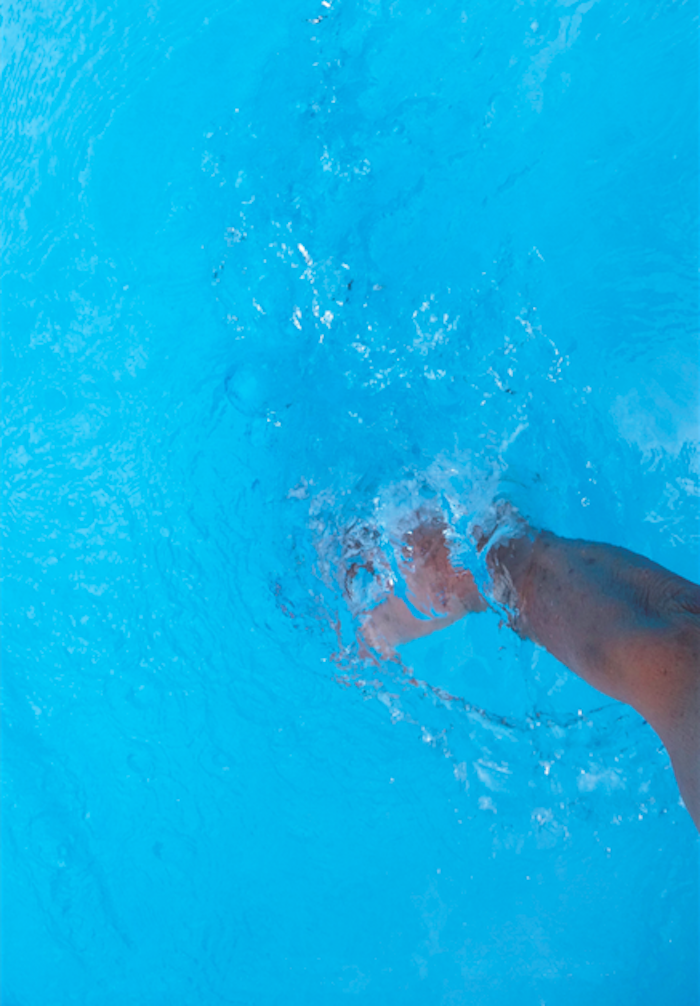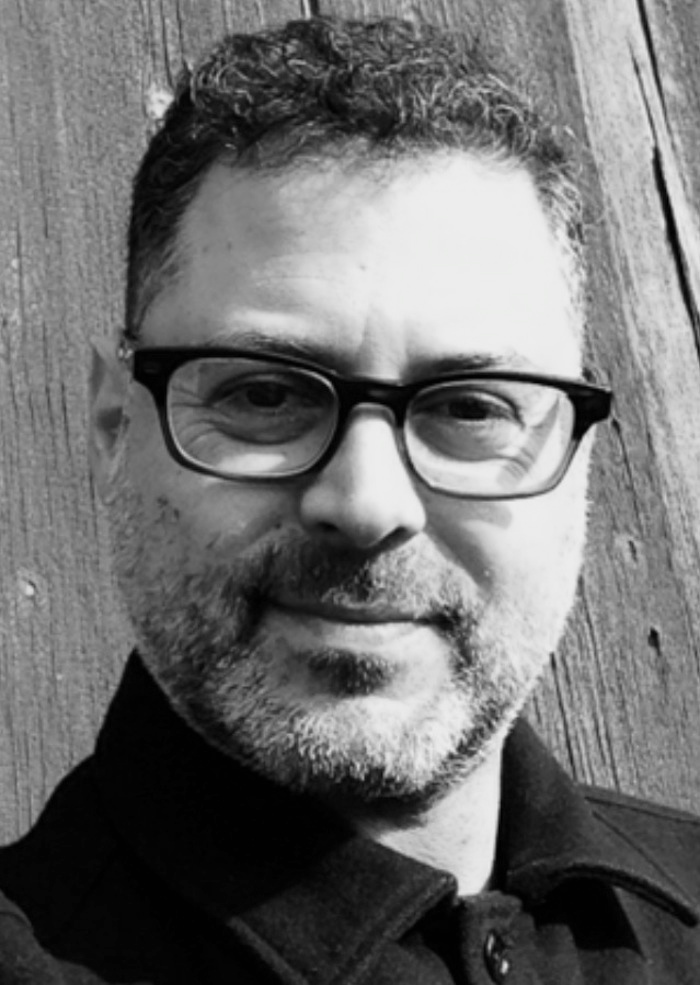
Robert Whitman, from Soundies
Robert Whitman, like his namesake Walt, is an artist who uses time, rhythm, and image to mesmerizing effect in his work. However, his poetry is not constructed from language, but from space. Whitman’s avant-garde credentials are unassailable: in the late 1950s and early ’60s, he was part of a group of artists including Jim Dine, Allan Kaprow, Claes Oldenburg Robert Rauschenberg, Red Grooms, Simone Forti, and Lucas Samaras. They transfixed and transfigured the New York downtown art scene through a number of theater pieces that became known as Happenings.
These were scripted and unscripted events staged with performers, film projections, found objects, and sets. The audiences were small but the ramifications of these pieces were large; in retrospect, they helped pave the way forward in art from the overwhelming dominance of the Abstract Expressionists who seemed to have taken their innovations in painting as far as they possibly could.
Whitman was essential to this scene and way ahead of his time when it came to forging interconnections between art and technology. Along with Rauschenberg, Billy Kluver, and Fred Waldhauer (the last two engineers from Bell Laboratories) Whitman was crucial to what became known as E.A.T. – Experiments in Art and Technology, which had its origins in the epic 9 Evenings: Theatre and Engineering at the 69th Street Armory, and which made use of emerging technologies such as sonar, video projection, and wireless sound transmission.
Whitman has always remained true to his impermanent form. He never produced the paintings or sculptural Pop objects that gave permanence to the work of Rauschenberg, Oldenburg, and Grooms. As a result, he has remained in the shadows of the great narrative of the New York art scene of the late 1950s and early ’60s.
Whitman’s work from the 1970s through the present continues to be both prescient and sublime, a word with transcendental resonance that is of a piece with his art. In 2003, DIA mounted a retrospective that brought him to the awareness of a younger generation of artists who found his desire to fuse technology, performance, and image as an exemplar for their own artistic explorations.

Robert Whitman, Swim

Robert Whitman, Swim
In preparation for this conversation I tried to dig up past interviews as a way to get a sense of how Whitman talks about his art. Very few exist. Like his non-narrative theater pieces, Whitman values experience over explanation, the visual image over linguistic verbiage. His tangential, associative, and sometimes poetic frame of mind is evident here. Our general theme was the use of sound in his work.
To read the complete interview buy a copy of Observer Quarterly 1: The Acoustic Issue.
To read the complete interview buy a copy of Observer Quarterly 1: The Acoustic Issue.
++++
Adam Harrison Levy: Sound has been in your work for a long time. Does sound enhance the image? Or does image enhance the sound?
Robert Whitman: I think they are separate elements. You know, how movement is a separate element. Sound is a separate element. The props are a separate element; the way they behave. They're all kind of separate elements that combine to make one overall image.
AHL: So it's like three or four dimensions that come together?
RW: Well, a friend told me that I used the word "multisensory."
AHL: That's a good word.
RW: Yeah, it's an okay word, as words go.
AHL: So what would be the "multi-?” Would it be the visual, the audio, the tactile? What would the senses be?
RW: Well, you smell stuff. I was trying to figure out a way because Swim was meant so specifically to be available to the blind. I told Jacob when we started working on it, “You know there's no way I could change what I do. But we'll just add in some elements or I'll just make other elements available to my vocabulary.” So like the smell. And also the coffee. [In the production of Swim a percolating coffee machine slowly made its way across the stage.]
AHL: Yes, the coffee, definitely. You could smell the coffee through the theater. It was amazing. I couldn't believe I could smell coffee from forty feet away. Someone said that you actually think like a composer.
RW: Oh really? Well, time in performance is very important. It's another subconscious element of composition and perception and I always think of it as a solid something—a building block, almost.
AHL: In the early 1960s your work seems purposefully not linear. It almost seems like you're going to a sort of earlier stage of theater where it's almost primordial or ancient or before words.
RW: That's why I say this piece is unusual and I didn't think it was necessary. I mean if I had wanted it to be like the other ones, I would have jumbled up—I wouldn't have the flow from image to image. But for some reason I thought, okay, let's let it be clear. I mean we could have had the coffee pot come out after the echocardiogram.
AHL: But it seemed to flow naturally from one to the other.
RW: But because I was in a booth and couldn't hear—the other guys had headsets—but the percolating of the coffee are another one of the sounds that are alive to the heartbeat. Stuff like that.
AHL: Is there a reason why you didn't use words in those early days, those early pieces? I'm thinking of Prune Flat or American Moon. [First staged in 1965 at the Jonas Mekas’ Film Makers Cinematheque during the Expanded Cinema Festival, this piece played with ideas of illusion and reality through the interplay of performers and the projected image. A large screen took up most of the stage. The first image was of a movie projector, the sound of it running. Two women dressed as nurses cross the stage, their heels clacking in the silence. Behind them images of a tomato and a pepper being sliced, their insides belching ball bearings, glitter and feathers, as well as bucolic landscape were projected. Onto a third woman is projected a version of herself doing various actions including brushing her hair and taking off her clothes. Her body and the projected image often meld into an eerie double image. Towards the end, climatically, a light bulb, which has been hanging over the stage, suddenly is turned on and one of the women throws a glass of water on it. It shatters. The house lights go up, the screen goes blank, and all that is heard is the sound of the projector.]
RW: They weren't necessary. You were talking about sound: in Prune Flat there were two sounds that I thought were important. One was the sound of the projector and the other was the sound of the heels walking on stage. (I always made sure they were wearing heels instead of sneakers.) In fact, what's funny is that—since they don't make 8mm projectors anymore and you have to use video—I had to record the sound of projectors for American Moon because I thought that sound was part of the piece. [American Moon debuted in 1960 at the Reuben Gallery. The audience was seated in six constructed bays that radiated from the central performing space. Each bay held ten people. At the end of each bay was a rough-hewn screen (layers of burlap and plastic sheeting) which was opened and closed during the course of the performance and on which images, fragmented and broken up by the materials, were projected. In the central space, the performers wrapped and swathed themselves in rags, rolled under balls stuffed with paper, and a huge plastic globe was inflated, under which two people crawled. At the end, a man was suspended over the audience swinging on a trapeze.]
AHL: That's ironic.
RW: You know, I have used sound in a lot of things. And one of the things that you're not aware of when you're listening to stuff is sounds have a funny way of articulating a space. They occupy it a different way and kind of shape it. And you know, as I said, it's not a good idea for me to think about this stuff too much. It just seems to work out that way. I didn't have the girls in this last piece wear heels except maybe one or two. We had a little discussion about it and decided not to do it; decided not to say that's what we're doing. I'm trying to think of what other ...
AHL: So, I don't want to be too programmatic about this, but there seems to have been assumptions in theater were breaking up in the late 1950s early ’60s about traditional theater and that you were trying to fill that void.
RW: It seemed like everybody was trying another idea. I mean, Red always thought of his things as plays. And, they were kind of like plays, the ones that I saw, and the movies that he made. They were very straightforward. Claes' things were more of a series of images. More or less related. Same with Bob Rauchenberg’s—the one with the roller skating around. That was really tight. And another piece of his called Open Score. Open Score is nine evenings and there is a video. The way they were done, the videos, of the Nine Evenings material. You have the performance, and you have the blather and sometimes mixed in with some of the blathers is a review of some of the images that were in the piece. I saw them all presented once in a little museum that had ten rooms. And each room had its own projection and no blather.
AHL: There was an English playwright who talked about how every artist is granted their own plot of land and all they can do is go back and forth and keep furrowing his or her field. They’re going to hit the same rocks, but they turn up in a different ways. What's your field and what are your rocks?
RW: I always use a little bit of a different image, which is, at a certain point you get stranded on an island of your own vocabulary and that's sort of it. And the only thing you can do is flip it in such a way that everybody else is unaware of the fact that you're basically making the same piece over and over again, because you really don't have any other choice.

